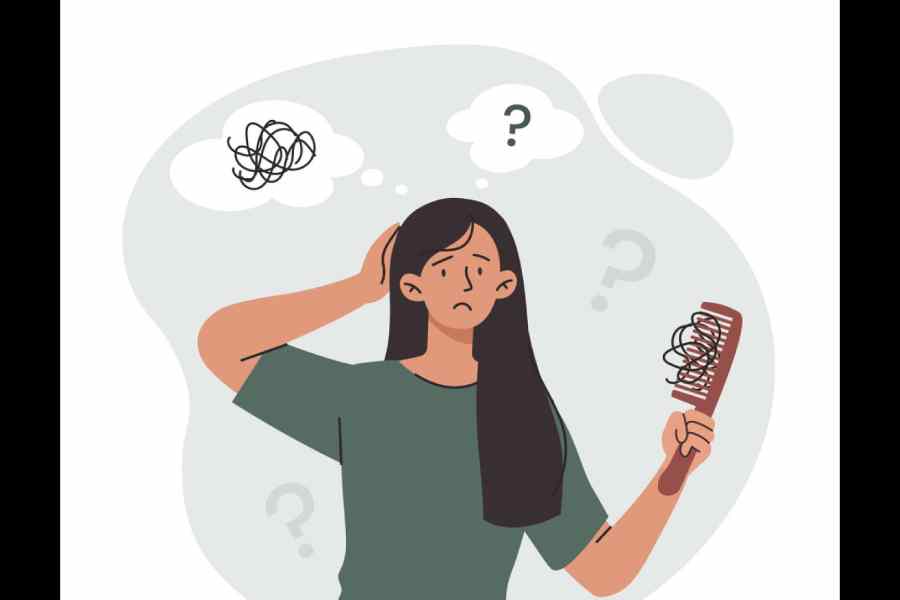As people age, their hair becomes brittle and less lustrous. The hair is no longer as thick and luxurious as it was in early adult life. As the brittle hair breaks, it appears that hair has thinned and there is hair loss.
Hair normally has a growth phase and a resting phase. As one ages, the growth phase becomes shorter and the resting phase longer. Thus, the hair does not grow as long as it did, and hair follicles also die. If these follicles are not replaced, hair becomes scanty.
Men are more likely to be affected. Although they may retain a luxurious moustache and beard, the hairline recedes and often a bald patch appears on the top of the head. This is called male pattern baldness and is inherited. The age at which it manifests varies. Women are less likely to develop male pattern baldness and more likely to have general non-concentrated hair loss all over the head.
Certain medications are likely to cause hair loss — and lifestyle diseases like diabetes and hypothyroidism. Hormonal changes with pregnancy, lactation and menopause also cause generalised hair fall. Deficiencies of iron, zinc and calcium, aggravated by funky diets, are likely to cause hair loss. Dandruff, eczema of the scalp and fungal infections like ringworm too can be the reason behind hair loss. Suddenly, without any of the above reasons, patches and clumps of hair may also fall out in a self-limited autoimmune disease called alopecia areata.
Check for all these problems. Correct them if possible, with specific medication, vitamins and mineral supplements.
If your tests are normal and your hair is brittle and breaking off (not falling out by the roots), you need to reconsider your hair care habits. A shampoo should be gentle, not harsh. Always read the label before buying shampoo. Avoid shampoos that contain sulfates, which may be used as a foaming agent. Also, avoid shampoos that have sodium chloride (salt), parabens, diethanolamine, alcohols, formaldehyde and silicone.
You need to check the label very carefully. Some “natural” and “herbal” shampoos have “foaming agents” added. These are chemicals that can damage your hair.
Take a blob of shampoo that is as big as a one-rupee coin. Add coconut or amla oil, mix it well and apply it to the head. Do not rub into the scalp or hair. Rinse off. Wipe gently. Avoid conditioner. If you need to use a hair dryer, place a thin cotton cloth over your head and apply the hair dryer to that. Avoid dyes and colouring agents. If you must use hair dye, you need to make sure that the dye is sulphate and paraben-free. A safer way to dye your hair is to use a mixture of two parts of indigo powder and one part of henna.
Both male pattern baldness and generalised hair loss can be tackled with applications of minoxidil. It should be applied and left on dry hair for four hours before shampooing. It takes 4-6 months for the hair to grow. The new hair may be fine and fuzzy, unlike regular hair. It also falls out if you stop applying the product.
Finasteride can be taken orally for baldness. It may take up to 12 months to show results. If you stop taking the tablet, hair loss occurs gain within a year.
All popular medications for hair loss, whether topical or oral, are not only slow-acting but also effective only as long as they used.
The above problem has made hair transplantation very popular. The technique is now fine-tuned and produces natural-looking results. The risks associated with hair transplantation are minimal, and success rates are typically high for properly screened and evaluated patients. Harvesting occurs in strips (FUSS) or individually (FUE) from the donor site. The procedure is time-consuming and can take from two to eight hours.
About six months after a hair transplant, the hair begins to take on a natural appearance and will keep growing for a lifetime.
The writer has a family practice at Vellore and is the author of Staying Healthy in Modern India. If you have any questions on health issues please write to yourhealthgm@yahoo.co.in











